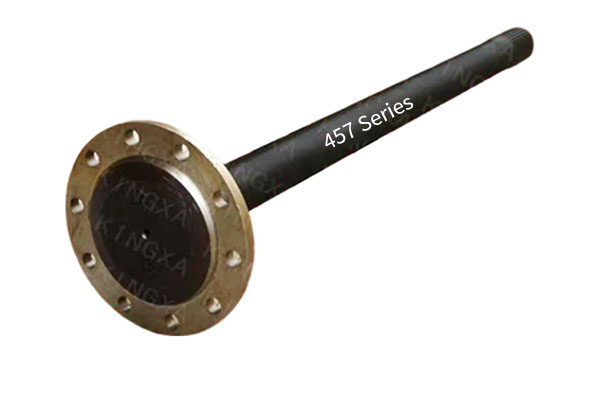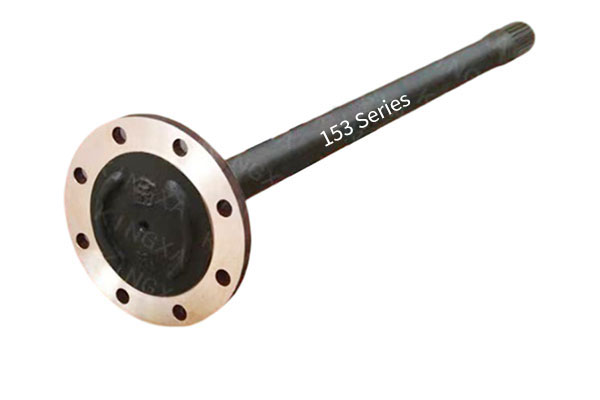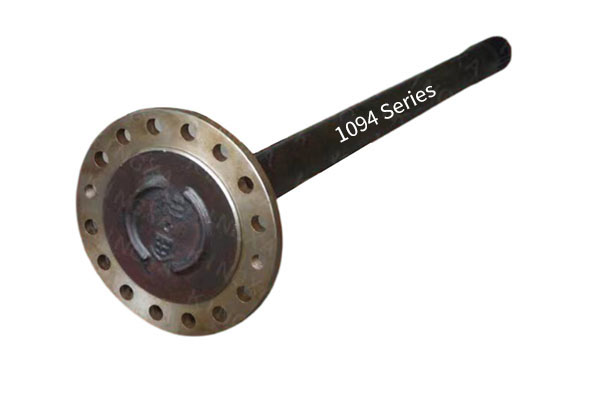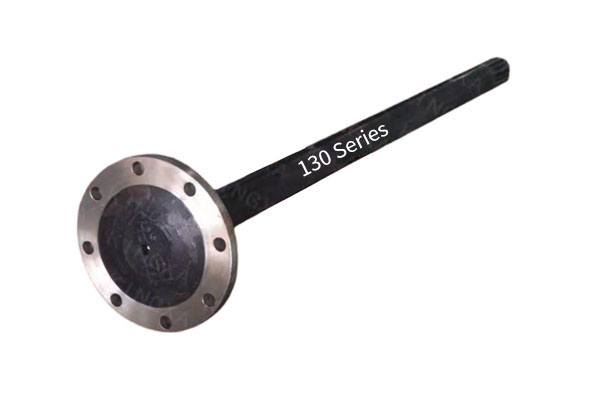How does the rear axle half shaft of a heavy-duty vehicle ensure reliable power transmission under high-torque conditions?
Release Time : 2025-08-18
The reliability of the rear axle half shaft in heavy-duty vehicles relies on its sophisticated structural design, the use of high-strength materials, and systematic response to complex stress environments. As a key component connecting the differential and the drive wheels, the half shaft bears the heavy responsibility of transmitting the powerful torque generated by the engine or electric motor to the wheels. In extreme operating scenarios such as heavy-load transport, hill starts, and harsh road conditions, the half shaft is subjected to extremely severe torsion, bending moments, and impact loads. Any minor weakness could lead to fracture or failure, so its reliability must be ensured through multi-faceted technical measures.
First and foremost, material selection is fundamental to ensuring the load-bearing capacity of the half shaft. Heavy-duty vehicle rear axle half shafts are commonly made of high-strength alloy steel, which not only possesses excellent tensile strength and toughness, but also maintains structural stability under complex stress conditions. Through a well-balanced alloy ratio, the material maintains surface hardness while retaining good ductility in the core, effectively resisting the initiation and propagation of fatigue cracks. This "hard exterior, tough interior" property makes the axle shaft less susceptible to brittle fracture when subjected to high torque shocks, while maintaining structural integrity under long-term alternating loads.
The manufacturing process plays a decisive role in the performance of the axle shaft. Monolithic forging is the current mainstream processing method. This high-temperature forging method creates a continuous distribution of metal fibers along the part contour, eliminating the structural weaknesses that can arise from welding or splicing. After forging, the axle shaft undergoes precision machining to ensure dimensional accuracy and surface finish in key areas such as the splines, journals, and flanges. The spline tooth profile and clearance are particularly carefully controlled to ensure a tight mesh with the differential output, ensuring zero slip and play during torque transmission and preventing tooth spalling or deformation caused by impact.
Heat treatment further enhances the mechanical properties of the axle shaft. Quenching and tempering imparts uniform mechanical properties to the material, while induction hardening strengthens the surface in high-stress areas such as the splines and shoulders, creating a hard, wear-resistant layer while maintaining the toughness of the core. This treatment effectively improves the fatigue resistance of the axle shaft, enabling it to operate stably and long-term under high-torque cycling conditions such as repeated starts and stops and heavy-load acceleration.
Structural design is also crucial. The axle shaft's geometry is optimized to avoid stress concentration. Large radius corners are used in the shaft-diameter transition area to reduce sudden stress changes. The bolt holes in the flange are evenly distributed to ensure balanced force during connection to the wheel hub. In dual-drive axles or large-tonnage vehicles, the diameter and length of the axle shaft are also matched to the vehicle's powertrain layout to prevent critical speed issues or torsional resonance caused by excessive length.
The sealing and lubrication systems are also crucial. The seal between the axle shaft's outer end and the wheel hub must be reliable to prevent lubricant leakage and the intrusion of dust and moisture. A good lubrication environment not only reduces wear on the splines and bearings but also effectively dissipates heat, preventing material degradation caused by high temperatures. Furthermore, the durability of the seals directly impacts the axle shaft's service life, so they are often made of heat-resistant and aging-resistant composite materials.
At the vehicle system level, the reliability of the axle shaft also depends on its coordinated fit with other components. The differential's output torque characteristics, suspension system stiffness, tire grip, and driving habits all affect the actual stress conditions on the rear axle. Modern heavy-duty vehicles are increasingly adopting electronic control systems, such as ASR traction control or torque management strategies, which proactively adjust output torque during slip or overload, preventing the rear axle from experiencing transient overloads and thus extending its service life.
Regular maintenance and condition monitoring are also key to ensuring reliability. By inspecting the rear axle for bending deformation, spline wear, and the tightness of the connecting bolts, potential hazards can be identified promptly. Some high-end models are also equipped with vibration sensors that can monitor abnormal driveline signals in real time and provide early warning of potential failures.
In summary, the reliability of a heavy-duty vehicle rear axle half shaft under high-torque conditions is not determined by a single factor but rather by the combined effects of materials, processes, design, system matching, and maintenance management. It silently carries enormous power loads under extreme conditions and is an indispensable "axle of power" for the stable operation of heavy-duty vehicles.
First and foremost, material selection is fundamental to ensuring the load-bearing capacity of the half shaft. Heavy-duty vehicle rear axle half shafts are commonly made of high-strength alloy steel, which not only possesses excellent tensile strength and toughness, but also maintains structural stability under complex stress conditions. Through a well-balanced alloy ratio, the material maintains surface hardness while retaining good ductility in the core, effectively resisting the initiation and propagation of fatigue cracks. This "hard exterior, tough interior" property makes the axle shaft less susceptible to brittle fracture when subjected to high torque shocks, while maintaining structural integrity under long-term alternating loads.
The manufacturing process plays a decisive role in the performance of the axle shaft. Monolithic forging is the current mainstream processing method. This high-temperature forging method creates a continuous distribution of metal fibers along the part contour, eliminating the structural weaknesses that can arise from welding or splicing. After forging, the axle shaft undergoes precision machining to ensure dimensional accuracy and surface finish in key areas such as the splines, journals, and flanges. The spline tooth profile and clearance are particularly carefully controlled to ensure a tight mesh with the differential output, ensuring zero slip and play during torque transmission and preventing tooth spalling or deformation caused by impact.
Heat treatment further enhances the mechanical properties of the axle shaft. Quenching and tempering imparts uniform mechanical properties to the material, while induction hardening strengthens the surface in high-stress areas such as the splines and shoulders, creating a hard, wear-resistant layer while maintaining the toughness of the core. This treatment effectively improves the fatigue resistance of the axle shaft, enabling it to operate stably and long-term under high-torque cycling conditions such as repeated starts and stops and heavy-load acceleration.
Structural design is also crucial. The axle shaft's geometry is optimized to avoid stress concentration. Large radius corners are used in the shaft-diameter transition area to reduce sudden stress changes. The bolt holes in the flange are evenly distributed to ensure balanced force during connection to the wheel hub. In dual-drive axles or large-tonnage vehicles, the diameter and length of the axle shaft are also matched to the vehicle's powertrain layout to prevent critical speed issues or torsional resonance caused by excessive length.
The sealing and lubrication systems are also crucial. The seal between the axle shaft's outer end and the wheel hub must be reliable to prevent lubricant leakage and the intrusion of dust and moisture. A good lubrication environment not only reduces wear on the splines and bearings but also effectively dissipates heat, preventing material degradation caused by high temperatures. Furthermore, the durability of the seals directly impacts the axle shaft's service life, so they are often made of heat-resistant and aging-resistant composite materials.
At the vehicle system level, the reliability of the axle shaft also depends on its coordinated fit with other components. The differential's output torque characteristics, suspension system stiffness, tire grip, and driving habits all affect the actual stress conditions on the rear axle. Modern heavy-duty vehicles are increasingly adopting electronic control systems, such as ASR traction control or torque management strategies, which proactively adjust output torque during slip or overload, preventing the rear axle from experiencing transient overloads and thus extending its service life.
Regular maintenance and condition monitoring are also key to ensuring reliability. By inspecting the rear axle for bending deformation, spline wear, and the tightness of the connecting bolts, potential hazards can be identified promptly. Some high-end models are also equipped with vibration sensors that can monitor abnormal driveline signals in real time and provide early warning of potential failures.
In summary, the reliability of a heavy-duty vehicle rear axle half shaft under high-torque conditions is not determined by a single factor but rather by the combined effects of materials, processes, design, system matching, and maintenance management. It silently carries enormous power loads under extreme conditions and is an indispensable "axle of power" for the stable operation of heavy-duty vehicles.







